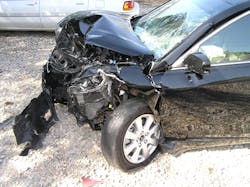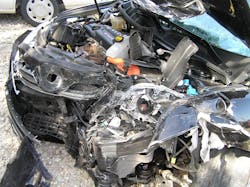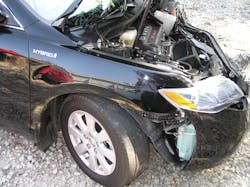Topic: Understanding vehicle badging challenges
Objective: Understand procedures for identifying hybrid and electric vehicles via badging
Task: The rescue team shall understand common vehicle badging and badging locations and be able to identify a vehicle type based on this information
You are the crew leader who is assigned to the sedan by the incident commander. You see that the lone occupant is a young female driver who is unbuckled but seated. From evidence that you see as you begin your walk-around, it’s apparent that the left front corner of the sedan collided with the front of the minivan. The collision appears to be a hard-impact type as you visually note significant damage on both vehicles.
The sedan rests on its four wheels. There is complete access to the vehicle: no obstructions are present.
From your 360-degree survey, you observe significant crash damage to the driver’s side of the vehicle; you see no damage to the passenger side or the rear of the vehicle. You order personnel from your crew to begin vehicle-stabilization efforts.
With chocks in place, cribbing set and tires deflated, the car is stabilized. Your medical personnel report that they can gain access to the driver through the front passenger-side door. Because it appears at first glance that the driver’s door is crushed and jammed, you tell them to access the interior through the front passenger door.
Unfortunately, during your 360 survey, the only badging on the entire driver’s side was obstructed, and you didn’t see that the vehicle is a hybrid. Regardless, with that much crash damage, the need exists to turn off the ignition and shut-down the 12-volt electrical system.
Once inside, medics report that the patient will be able to be removed through the front passenger side door. You make a second circle around the vehicle, this time looking more closely at its physical condition. You confirm that not only is the driver’s door jammed, but the driver’s side rear door also won’t open normally.
The focus of this article is recognizing and understanding exterior hybrid and electric vehicle (EV) markings, or badging, that are present on almost all hybrids and EVs. Understanding where they are, what they mean and what the difference is when dealing with a hybrid or EV is important to the safety of responders and of injured persons.
Hybrids and EVs that are sold in the United States aren’t required to have exterior badging that designates them as such. In fact, several models of these vehicles lack exterior markings or badging that identifies them as a hybrid or EV.
The most likely exterior location for badging is at the rear of the vehicle on the trunk lid or liftgate. When only one badge is included, it’s considered single-side badging. Three-sided badging includes badging at the rear as well as on both side fenders or door panels. Four-sided badging includes each side and the front and rear.
Toyota and Lexus (brands of Toyota Motor Corporation) started using four-sided badging as the norm with their 2007 model-year vehicles. In addition to side badging, responders will see the brand logo surrounded by a circular blue shadow at the front and rear of these hybrid sand EVs.
The Society of Automotive Engineers’ recommended standard (J2990) provides guidance to automakers regarding hybrid and EV badging. In that document, badging can include plain-English wording, such as Toyota’s “Hybrid Synergy Drive,” or initials, such as “EV” and “PHEV.” In lieu of this, the automaker can use what is referred to in the document as “unique” badging. Nissan’s “LEAF,” Chevrolet’s “VOLT” and the “T” that’s used by Tesla are examples of unique hybrid/EV badging.
Back to our crash incident: During your exterior survey, you observe no evidence of badging along the driver’s side of the vehicle. The crushing of the front fender as a result of the collision blocked the hybrid badging on the driver’s fender.
Because you don’t see badging on the driver’s side, you don’t realize at this point that you and your crew are dealing with a damaged hybrid.
Fortunately for you and the other responders, the sedan is a Toyota Camry Hybrid, and it utilizes three-sided hybrid badging, and during your walk-around, you see hybrid badging on the front passenger side fender. You now know that you’re dealing with a vehicle that has a high-voltage electrical system.
The inside crew now can be coached to make sure that they place the car in “Park” and turn off the ignition. The trunk now can be opened to shut down the 12-volt electrical system at the battery (the completion of the hybrid/EV lock out/tag out protocol).
The University of Extrication-recommended seven-step hybrid/EV lock out/tag out protocol was created prior to the delivery of the first hybrid vehicles in 2001. Although 19 years old, this protocol is just as relevant today as it was for the 2001 vehicles to ensure responder safety.
Potential Hybrid/EV Info Sources
- Exterior badging (rear, sides and/or front)
- Make/model/year of vehicle
- Orange-colored cables, connectors, etc.
- Owner/operator/occupant of vehicle
Hybrid/EV Lock Out/Tag Out Protocol
- Identify vehicle as a hybrid or EV
- Stabilize vehicle
- Access interior
- Place in “Park”
- Turn off ignition
- Note instrument panel changes
- Complete 12-volt power shutdown
About the Author
Ron Moore
RON MOORE, who is a Firehouse contributing editor, recently retired as a division chief with the McKinney, TX, Fire Department and now serves with Prosper, TX, Fire Rescue. He self-published the Vehicle Rescue 1-2-3 training manual and serves as the forum moderator for the extrication section of Firehouse.com . Moore can be contacted directly at [email protected].




